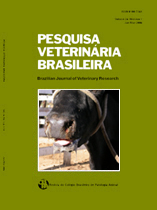 |
|
|
|
Year 2007 - Volume 27, Number 07
|

|
Meningoencephalitis by bovine herpesvirus-5, p. 251-260
|
ABSTRACT.- Rissi D.R., Rech R.R., Flores E.F., Kommers G.D. & Barros C.S.L. 2007. [Meningoencephalitis by bovine herpesvirus-5.] Meningoencefalite por herpesvírus bovino-5. Pesquisa Veterinária Brasileira 27(7):251-260. Departamento de Patologia, Universidade Federal de Santa Maria, 97105-900, Santa Maria, RS, Brazil. E-mail: claudioslbarros@uol.com.br
Meningoencephalitis caused by bovine herpesvirus-5 (BoHV-5) is an often fatal, acute or subacute infectious disease that affects mainly young cattle under stressing conditions. The disease has been recognized in several Brazilian regions and in other parts of the world. BoHV-5 is a double stranded DNA virus member of the Herpesviridae family and subfamily Alphaherpesvirinae. The virus is characterized by rapid and lytic replication in cell cultures and by the ability to establish lifelong latent infection in sensory nerve ganglia of the host. BoHV-5 is transmitted mainly by direct and indirect contact and replicates acutely in the oral, nasal, oropharingeal or ocular mucosae. After primary replication, the virus invades nerve endings and is transported to the neuron cell bodies of the sensory ganglia where it replicates actively and/or establishes latency. Viral invasion of the brain may result in massive virus replication and production of neurological disease. Virtually all cattle developing neurological disease die of meningoencephalitis; yet the infection may be subclinical in some animals. These animals recover and become latently infected. Viral dissemination within a herd is facilitated by conditions such as crowding, introduction of cattle from other herds and weaning of calves in ages that coincide with decrease of passive immunity. Certain natural or induced conditions may reactivate the latent virus and favor its transmission and dissemination to other susceptible individuals. The disease may occur as outbreaks or as sporadic cases, with morbidity rates ranging of 0.05%-5%; lethality is almost always 100%. Clinical signs include depression, nasal and ocular discharge, grinding of teeth, circling, blindness, fever, paddling movements, disphagia, abdominal pain, nystagmus, muscle tremors, drooling, incoordinated gait, opisthotonus, head pressing, falls and convulsions. Clinical course is usually 1-15 days. Necropsy findings may be absent but often there is swollen of the rostral portions of the cerebral cortex and flattening of gyri, with softening and segmental yellow discoloration (malacia). As the disease progresses the affected areas become gelatinous and grey and, in advanced cases, there is segmental loss of the cerebral cortex of the frontal lobe of the brain (residual lesion). In several cases there is malacia of the basal nuclei and of the thalamus. Histologically, there is necrotizing non-suppurative meningoencephalitis affecting mainly the cerebral cortex of the frontal lobe associated with eosinophilic intranuclear inclusion bodies in neurons and astrocytes, although the frequency of the inclusion bodies is inconsistent. The diagnosis of meningoencephalitis by BoHV-5 should be based on epidemiology, clinical signs, necropsy and histological findings. The diagnosis should be confirmed by viral isolation in cell culture and/or by detection of viral antigens in brain sections or in exfoliated cells from nasal secretions. The identification and characterization of BoHV-5 can be done by the use of monoclonal antibodies, polymerase chain reaction (PCR) and/or by restriction enzyme analysis of the viral genome. There is no specific treatment for the disease. As BoHV-1 and BoHV-5 are antigenically related, vaccination using BoHV-1 vaccines may be recommended as a means of reducing the losses caused by BoHV-5 infection, mainly during outbreaks of neurologic disease. Additionally, measures such as serologic testing of new additions to the herd; and management practices to prevent stress and to reduce conditions for virus dissemination among animals may help in reducing the incidence and the consequences of BoHV-5 infection and disease. |
| |
|
|
| |
|
 |